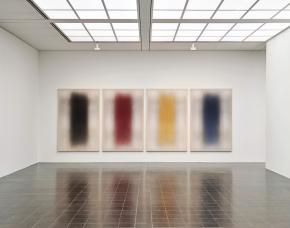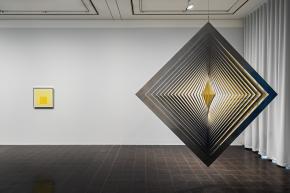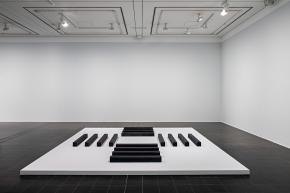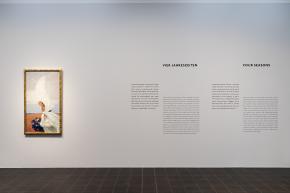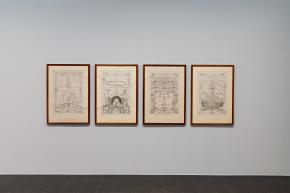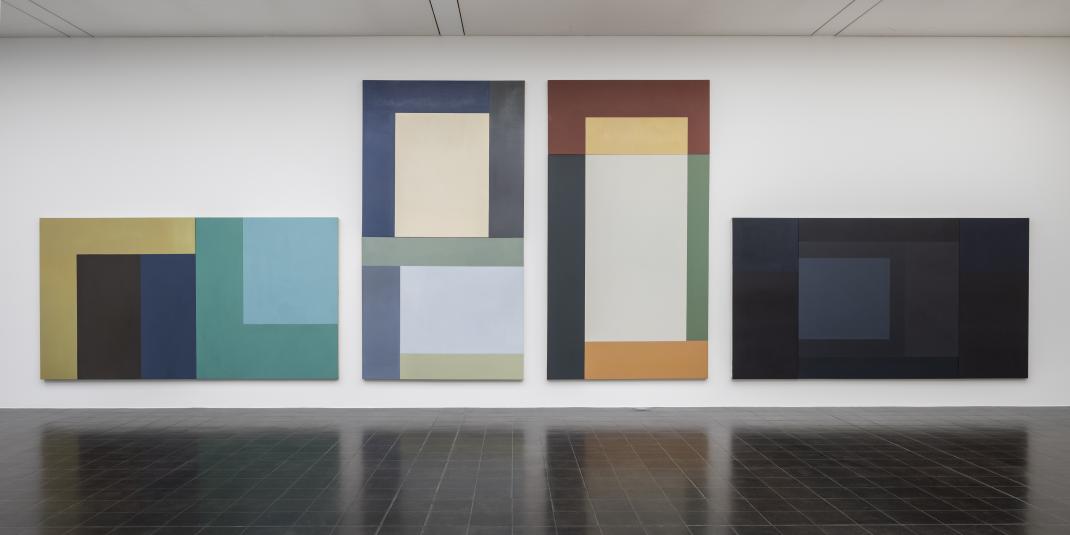
Viermalvier / Fourtimesfour
The number four is charged with significance in European intellectual history: there are four points of the compass structuring the world and our days are divided into four times of day. Four elements describe the composition of the world according to Greek natural philosophy. The development of a human being is divided into four phases of life. It is the quarter that supports the consistently calculated completion of projects undertaken in the course. In music, the quadruple meter represents a certain weightiness or even majesty. The square stands for symmetry and quadrilateral forms are the basic geometric shape of architecture.
The exhibition VIERMALVIER / FOURTIMESFOUR associatively draws on various layers of meaning related to the number four. After DIE ABSURDE SCHÖNHEIT DES RAUMES (2020) and OUT OF SPACE (2021), this show once more takes the architecture of the Gallery of Contemporary Art created by Oswald Mathias Ungers and its specific spatial conditions as the starting point for curatorial consideration. Opened 25 years ago, the bright building complex of the Gallery of Contemporary Art – whose design on the inside and perception from the outside are determined by its square shape – has repeatedly been rearranged and reinterpreted by the art presented there. The exhibition rooms extending around four corners, with four walls each, provide an inspiring setting for an exhibition layout that places the space, people and art in an equal relationship to one another.
What has this “series of fours” evoked in art? Which forms can artistic exploration of this number inspire, especially in a place undeniably based on it in the form of the square? The exhibition VIERMALVIER / FOURTIMESFOUR, comprising 18 positions (sure enough: eighteen!), is deliberately associative, mathematically incorrect, incomplete and rule-breaking. Yet it is precisely the breach of rules that wants to point to the perfection underlying the four. Nam June Paik postulated, “When too perfect, lieber Gott böse.” And this is why the exhibition is the way it is: with too short a duration, manifold possibilities of association for the viewers and a hanging as precise as a fugue by Johann Sebastian Bach.
VIERMALVIER / FOURTIMESFOUR is a presentation of the museum collection extended to include selected guests, combining the known with the unknown, the already shown with the never yet presented, the new with the old. The exhibition combines works from the 17th century with positions from the 19th and 20th centuries alongside contemporary art. Alfons Mucha’s lithograph series from 1897 converge with auratic paintings by Vivian Greven created especially for the exhibition, and an expansive sculpture by Hamburg-based artist Frank Gerritz from 2021 interacts with both a kinetic object by Tomitaro Nachi created in the 1970s and a small-format study by Josef Albers from 1965. The exhibition opens with David Novros’s monumental four-part painting Four Seasons from 1974. Referencing the presumably best-known concert cycle by the composer Antonio Vivaldi, Novros transferred the sequence of the four movements to four large horizontal and vertical rectangular image planes. In juxtaposition, we find Vier Jahreszeiten. Opus 7. Der Mond ist aufgegangen (Four Seasons. Opus 7. The Moon Has Risen) by Hanne Darboven, one of the notation systems transferred from her number systems, and Hanns Kunitzberger’s four paintings 1. Hälfte 2019 I, II, III, IV (1. Half of 2019 I, II, III, IV), which in their statuesque vertical format and flickering colours associating movement or even ecstasy echo US colour field painting and minimal art as well as Albrecht Dürer’s The Four Apostles. The result is a compilation of works charged with tension in terms of form, content and media, calling on us to re-examine the individual artistic positions and challenging us to relate them to the space they explicitly interact with.
Haspa-Galerie
Hamburger Sparkasse has been committed to the Hamburger Kunsthalle for many years. As a sign of gratitude for this generous support, the 2nd upper floor of the Gallery for Contemporary Art, where the exhibition is shown, has been called »Haspa Gallery« since the end of 2019.
Participating artists: Josef Albers, Elsbeth Arlt, Hanne Darboven, Frank Gerritz, Vivian Greven, Roni Horn, Donald Judd, Imi Knoebel, Hanns Kunitzberger, Dorothea Maetzel-Johannsen, Alfons Mucha, Tomitaro Nachi, Reinier Nooms alias Zeeman, David Novros, Sigmar Polke, Franziska Reinbothe, Philipp Otto Runge, Fred Sandback

